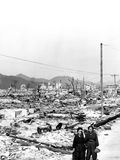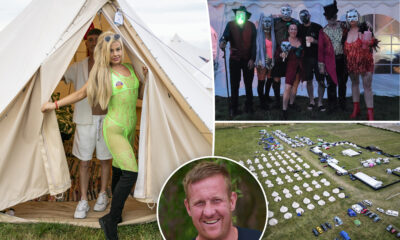Science
Hiroshima Survivors Share Their Lives Eight Decades After the Bomb

Survivors of the atomic bombings in Hiroshima and Nagasaki continue to grapple with the profound effects of the events that transpired over **80 years ago**. Kazumi Kuwahara, a **third-generation hibakusha** and a resident of Hiroshima, recently addressed a conference in London, discussing the ongoing health and psychological struggles faced by those affected. Her personal account highlights the enduring legacy of the bombings that occurred on **August 6 and 9, 1945**.
Kuwahara, who was born with health complications, shared her experience of persistent illness throughout her life, punctuated by a benign tumor that required surgery at the age of 25. Her grandmother, **Emiko Yamanaka**, a direct survivor of the Hiroshima bombing, expressed remorse over the family’s ongoing health issues, stating, “I’m sorry, it’s my fault.” Kuwahara emphasized that the trauma of the atomic bomb did not end with the explosion; it continues to cast a long shadow over the lives of hibakusha.
The Immediate Aftermath of the Bombing
The atomic bomb, known as **”Little Boy,”** detonated over Hiroshima at **8:15 AM** on **August 6, 1945**. The explosion, which occurred approximately **600 meters** above the city, resulted in a fireball that reached temperatures of **3,000 to 4,000 degrees Celsius** and created a mushroom cloud that ascended **16 kilometers** into the atmosphere. In its immediate aftermath, the bomb’s devastating effects were felt within a **4-kilometer radius**, with radiation exposure leading to severe health complications for many survivors.
In the days following the bombing, the Japanese military imposed censorship, rendering the words “atomic bomb” taboo. This suppression continued during the U.S. occupation, which began after Japan’s surrender on **September 2, 1945**. The lack of open discussion about the bomb’s consequences contributed to the stigma faced by hibakusha, complicating their efforts to find employment and form relationships.
Yamanaka, who was just **11 years old** when the bomb was dropped, recalled her harrowing escape from the blast. After returning to Hiroshima with her mother and younger brother for a doctor’s appointment, she experienced the bomb’s catastrophic effects firsthand. “When I was repairing my strap, there was a flash. I was blinded for a moment,” she recounted, describing the chaos that followed the explosion.
The Long-Term Impact on Survivors
The long-term health consequences for hibakusha include a wide range of ailments associated with radiation exposure, such as cancer and immune deficiencies. Yamanaka’s family has faced numerous health challenges over the years, including serious illnesses experienced by her daughters. As of **March 31, 2025**, approximately **99,130** hibakusha remain alive, with their average age now **86**.
In the wake of the bombings, many survivors found themselves grappling with societal discrimination and a sense of isolation. Despite these challenges, there has been a concerted effort within the community to share their experiences and preserve their histories. Local organizations, such as the **Chugoku Shimbun**, are working to create networks among hibakusha, facilitating opportunities for storytelling and memory-sharing.
Kuwahara, who began sharing her grandmother’s story at just **13 years old**, is among a new generation of voices committed to educating others about the impact of the atomic bomb. She has trained as a **denshosha**, or peace park guide, dedicating herself to helping visitors understand Hiroshima’s history through personal narratives. “Each visitor has a unique nationality and upbringing, and, as I interact with them, I constantly ask myself how best to share Hiroshima’s significant history,” she stated.
As time passes and the number of survivors dwindles, it becomes increasingly vital to document and disseminate their stories. The ongoing efforts to connect younger generations with these narratives serve as a poignant reminder of the resilience and strength of those affected by the bombings. As noted by **John Hersey**, author of the seminal work *Hiroshima*, “What has kept the world safe from the bomb since 1945 has been the memory of what happened at Hiroshima.”
The stories of hibakusha like Kuwahara and Yamanaka not only illuminate the harrowing realities of nuclear warfare but also emphasize the importance of remembrance and education in preventing future atrocities. Their experiences provide essential insights into the human cost of conflict and the enduring hope for peace.
-

 Lifestyle2 weeks ago
Lifestyle2 weeks agoLibraries Challenge Rising E-Book Costs Amid Growing Demand
-

 Lifestyle1 week ago
Lifestyle1 week agoSave Your Split Tomatoes: Expert Tips for Gardeners
-

 Sports1 week ago
Sports1 week agoLiverpool Secures Agreement to Sign Young Striker Will Wright
-

 Lifestyle1 week ago
Lifestyle1 week agoPrincess Beatrice’s Daughter Athena Joins Siblings at London Parade
-

 Science1 week ago
Science1 week agoTom Lehrer, Pioneering Satirist and Musician, Dies at 97
-

 World4 days ago
World4 days agoWinter Storms Lash New South Wales with Snow, Flood Risks
-

 World1 week ago
World1 week agoSwingathon Festival Draws Nearly 1,000 Attendees in Allington
-

 Lifestyle1 week ago
Lifestyle1 week agoNigeria Claims 10th African Championship Title with Victory Over Morocco
-

 Politics1 week ago
Politics1 week agoNorth Dakota Woman Dies in Lake Crash Following Highway Incident
-

 Science2 weeks ago
Science2 weeks agoTrump Administration Moves to Repeal Key Climate Regulation
-

 Business2 weeks ago
Business2 weeks agoSoFi Technologies Shares Slip 2% Following Insider Stock Sale
-

 Entertainment2 weeks ago
Entertainment2 weeks agoKendra Scott Engages Zac Brown, Expands Family with Stepchildren









